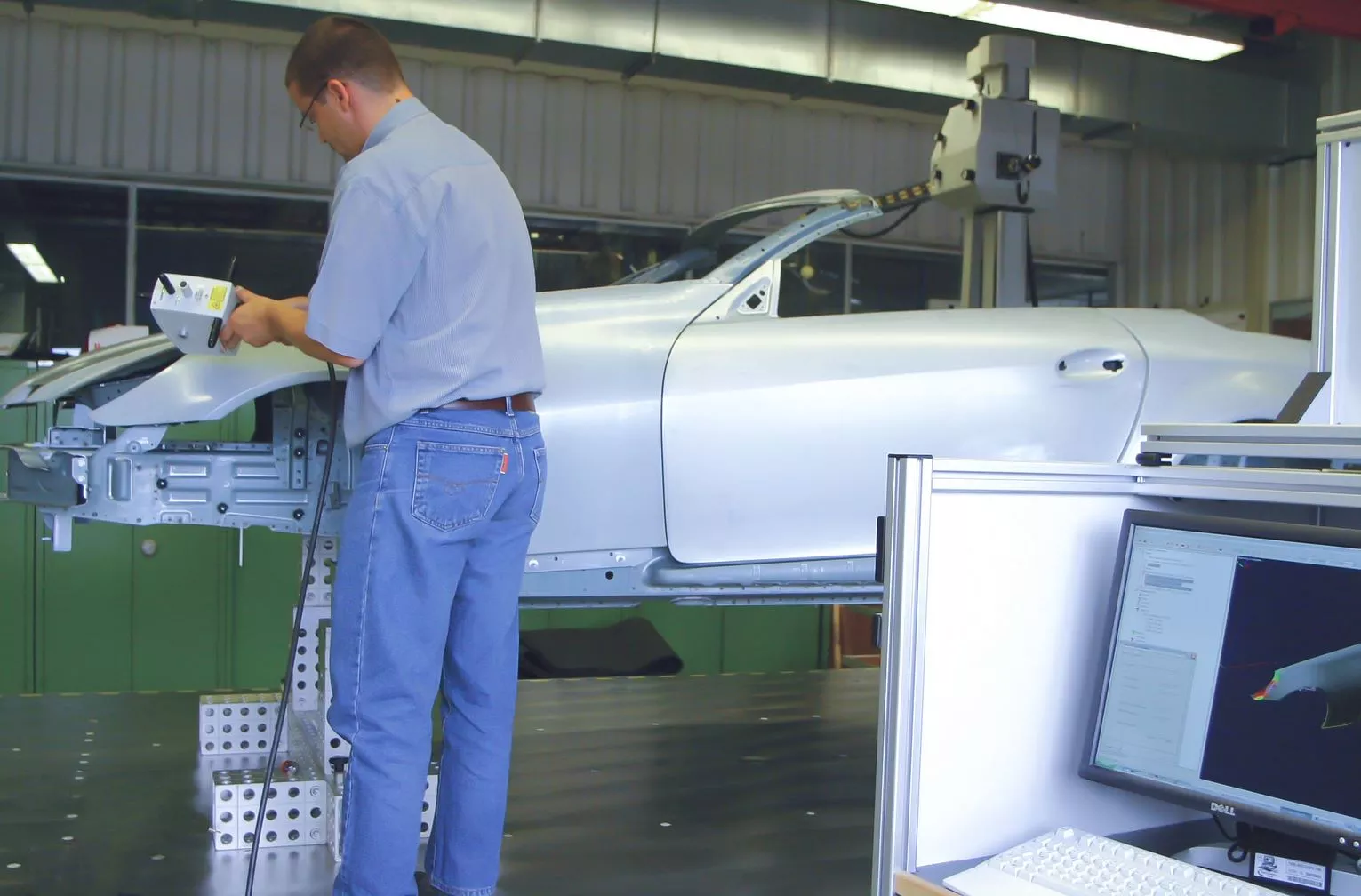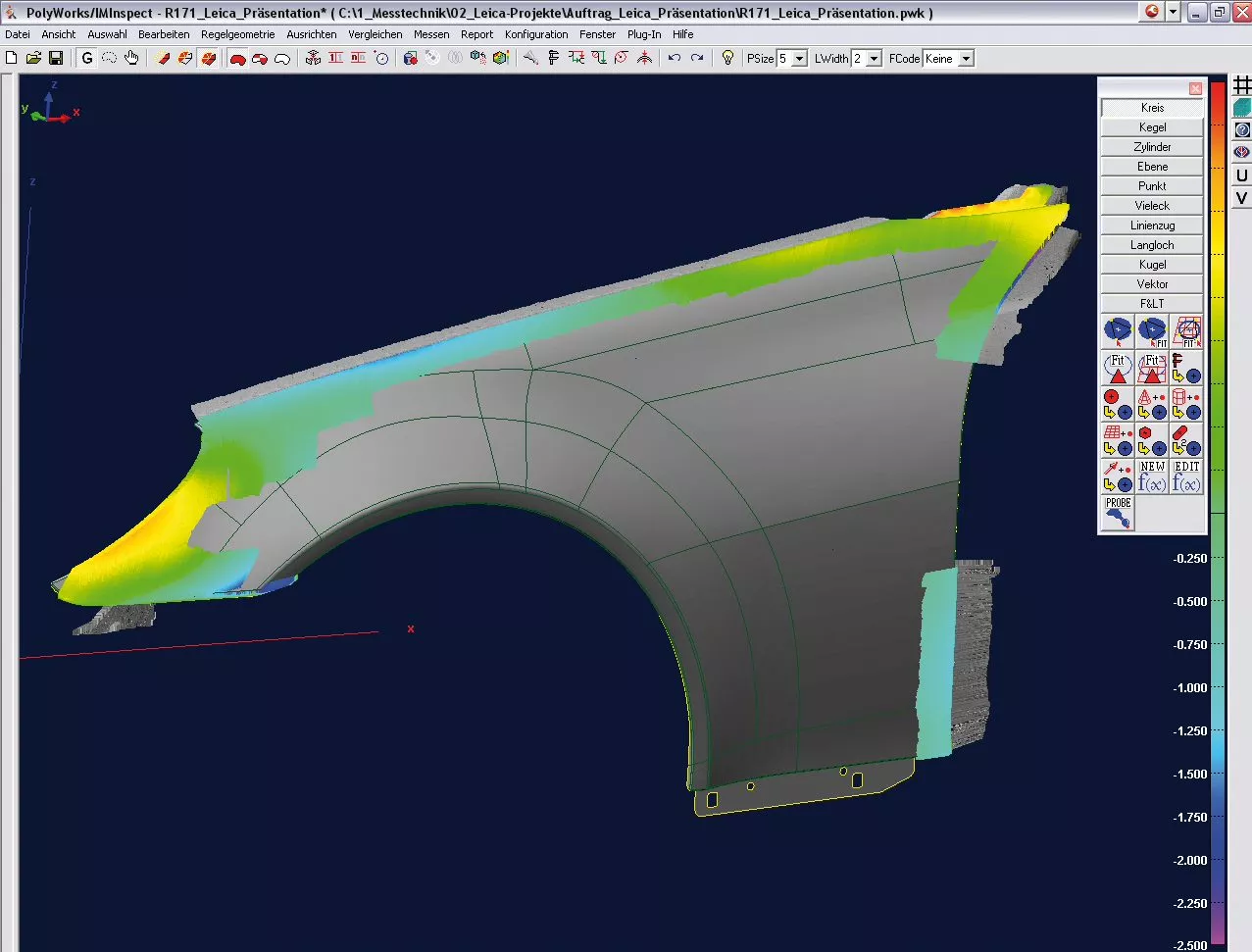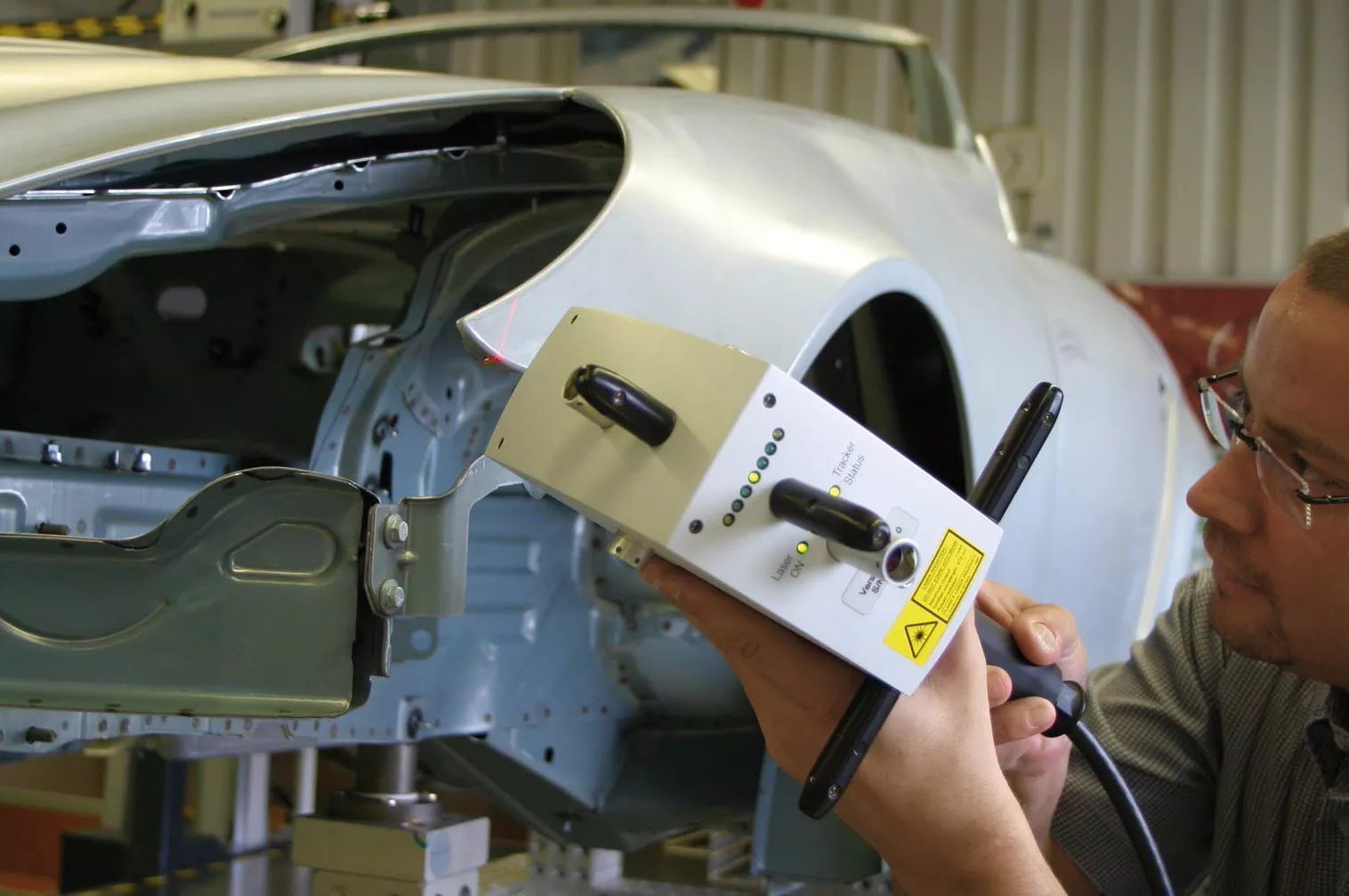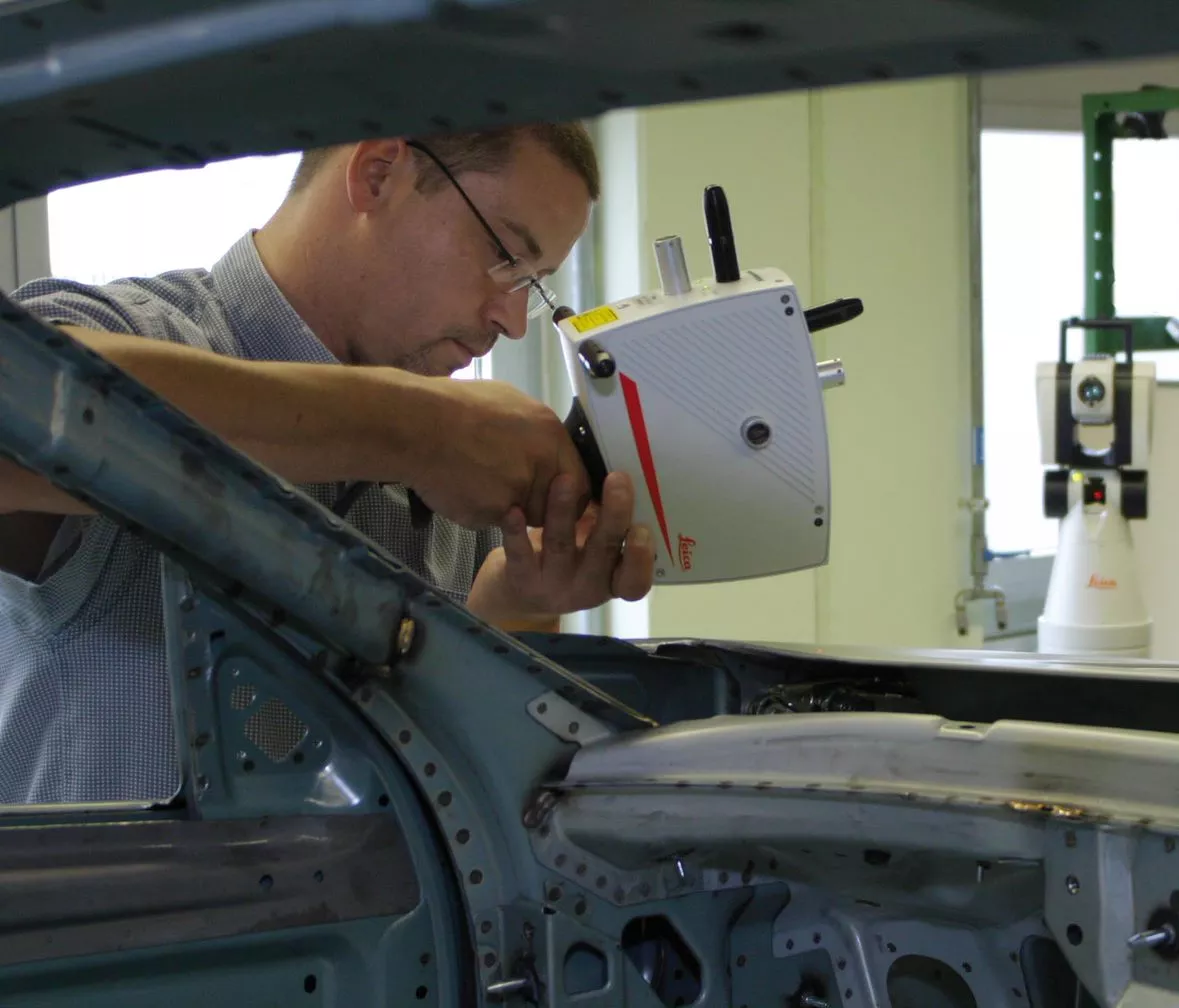Looking for a perfect fit
Daimler AG relies on InnovMetric and Leica for optimal part fitting.
Daimler AG has a product portfolio that includes micro-cars, performance coupes, sedans and station wagons, versatile vans, and commercial vehicles. The second largest Daimler AG plant in Germany is the Bremen plant, which employs nearly 14,000 people and has a floor space of 850,000 square meters. The SL and the SLK roadsters, as well as all versions of the C-class (sedan, station wagon, coupe and convertible) are produced there.
The first thing you’d notice when walking up and down the seemingly endless corridors of Daimler AG‘s sleek, ultra-modern Bremen plant is the almost complete absence of people. Hundreds of robots go about their work with surgical precision, bringing different sheet metal parts into place, welding them together, moving completed parts onto the next station and transporting finished products overhead to maximize space utilization. Viewed from afar, the ubiquitous robots seem to be dancing. The few factory workers that you do see use “old school” bicycles to jet between different parts of the factory: hi-tech and low-tech harmoniously coexist here side by side.
Technological progress in the manufacturing processes has meant that more daring body shapes can make the leap from the designers’ drawing board to the assembly line. In the not-so-distant past, cars had relatively simple, square shapes, with individual parts fitting to one another along more or less straightforward lines. On the other hand, modern cars boast far more complex shapes than the cars of the past. And the task of inspecting how these parts fit to one another has gotten increasingly more complex as well.
The Body-In-White (BIW) Rollout and Process Optimization Department tackles exactly that task: it is entrusted with the job of inspecting how the various body parts fit to one another. More importantly, based on their measurements, feedback is given to the production facilities so specific, targeted adjustments can be made on the tools.

Dirk Noffke, a metrology technician at Daimler AG Bremen, inspects the dimensional accuracy of the left fender on a Mercedes SLK Body-in-White. The comparison between the actual data and the CAD data is displayed in real time in the PolyWorks|Inspector™ software.
The Challenge
Operational Engineer Henning Siemers is involved in BIW measurement and inspection tasks. He explains: “Our job is to assure the dimensional accuracy of the entire body-in-white. Of course, every BIW consists of many individual parts, and they must all fit perfectly. Our primary duty is to inspect the entire BIW, both individual parts and the whole vehicle, including the panel gaps, and then analyze the data that we get. Based on the analysis we perform, we then go back to the production facilities and make adjustments to the tools and make sure that what comes out is an automobile whose parts fit together flawlessly.”
The complexity of today’s car shapes and the ever-increasing tolerances have pushed traditional instruments to their limits.
In the past, Mr. Siemers’ department relied on hand-operated measurement instruments. “Viewed in retrospect, cars used to be made of almost square-like segments, which used to fit nicely together without much hassle. Nowadays, cars are much curvier, with round areas suddenly changing shapes and meeting other panels at all kinds of angles and lines. Plus, the much higher requirements for the nearly seamless fit between individual panels mandate that we work with very tight tolerances.”
The Solution
With the shapes of their vehicles getting more complex, Siemers and his team have been on the lookout for new technologies that deliver. “Each year, our Quality Engineer, Karl-Heinz Boecker, attends the CONTROL trade show in Sinsheim, Germany, where he had his first encounter with the Leica T-Scan system a couple of years ago, when it was only a prototype. Based on the announced specs, we knew this could be something for us, but we wanted to wait until we were positive that the product was truly ready for the market. The primary issue that we saw with many of the other scanning solutions out there was that the software could not keep up with the hardware. Collecting all those points is relatively simple, but what do you do afterward? We were under the impression that many manufacturers did not award the same attention to the software as they did to the hardware. ” A few months ago, Mr. Boecker’s team arranged a Leica Geosystems product demonstration at their facilities. A Leica LTD840 Laser Tracker coupled to a Leica T-Probe and Leica T-Scan—the top-of-the-line combination—was chosen. And the Leica system delivered.

Deviations from CAD data are visually displayed using the PolyWorks|Inspector software, with deviations shown either using a color map or vectors. The information is analyzed in order to yield correction instructions, which are then implemented directly on the tools.

The Leica T-Scan and the PolyWorks® software solution proved to be a mighty combination!
"We already knew that the Leica T-Scan was a great sensor, and we were also shown that the PolyWorks suite is a worthy match for it. The software is very capable, and we knew we would be on the right track," stated Siemers.
Change is good
Since the system delivery, the Leica T-Probe/T-Scan system has been used, among other things, to measure panel gaps, examine part curvatures, inspect reference holes and similar. Siemers has also been busy testing different applications for the Leica T-Scan system. “One of the new applications we have found is inline calibration. In the past, BIWs were inspected by being placed inside a grid station and measured using conventional CMM equipment. When you have 150 pallets and want to measure with high tolerances, you‘re quickly reaching the limits with traditional methods. That’s why we wanted to be able to measure inline, both the pallets and the tools, and this is where the Leica T-Scan system will come into play. Another application of interest to us is the inspection of the entire robot path, and this is something we plan on doing in the near future.”
The Benefits
Asked about what has changed since the implementation of the Leica T-Scan system and PolyWorks, Siemers is very specific: “By relying on scanning, I am in the possession of much more useful information. The quality of part analysis has improved, we are able to get to the root of a problem much more quickly, therefore coming up with targeted solutions for what needs to be changed, for example intervening at the tools, at a specific point, and changing the parameters based on the results seen in PolyWorks.”
And benefits of using the Leica T-Probe/T-Scan and PolyWorks system are manifold. “We really appreciate the portability. With the Leica Geosystems equipment, I can gather all the information I need in just 2-3 hours and perform the analysis later. This way, I am not blocking production for too long because the system lets us work in parallel: while one operator is taking the measurements, another one can already be working on sorting out the results.”
The Leica T-Probe/T-Scan combo measures within a range of 15 m, giving the technicians a volume of 30 m in which they can operate. This gives Henning Siemers and his team peace of mind in knowing that should the measurement requirements change in the future, they are well equipped for working in a measurement volume large enough to accommodate several BIWs at once.
The fact that the system is modular is important to Siemers’ team. “We purchased a Leica T-Probe at the same time that we got the Leica T-Scan. Tactile wireless measurement is of great value to us when we measure easily twistable parts like the hood. We perform a quick measurement with the Leica T-Probe to get a rough idea about the condition of the part. If we were to start scanning immediately, it would take longer to realize that the hood is twisted. With the Leica T-Probe, collecting just a few points will let us immediately know how we are doing. And we are performing this all within PolyWorks, merely switching between the Leica T-Probe and the Leica T-Scan.”

Thanks to the large operating volume of the Leica T-Scan system, which can measure objects in the range of 15 m, an entire side of the body-in-white can be inspected without repositioning the Leica Laser Tracker. The operator moves along the vehicle, back and forth, and the Leica Laser Tracker maintains a lock on the Leica T-Probe/T-Scan within the entire measurement volume.